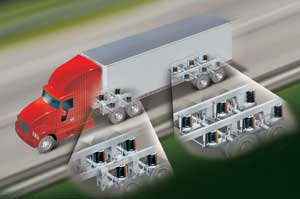
Trailer air suspensions offer fleets many benefits, including optimized fuel efficiency and tire life, superior cargo protection, improved ride characteristics and minimized wear and tear on trailer components.
These advantages can be maximized with some basic knowledge concerning the ins and outs of air suspensions, along with a good understanding of maintenance practices. We asked several manufacturers of trailer air suspensions to weigh in on the subject, and their advice could save fleets a significant amount of time and money—both valuable resources.
|
Air suspension maintenance checklist
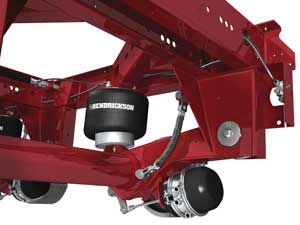
John Healy, aftermarket air springs marketing specialist for Veyance Technologies, offers the following maintenance checklist:
• Check air lines and fittings for leaks and for rubbing on the air spring.
• Check for proper clearance around the air spring when inflated. Generally, a minimum of 36 mm will allow for the increased diameter that occurs in heavy jounce.
• Periodically check the suspension for proper ride height. This dimension should be maintained at +/- 7 mm to protect the springs and shocks from over-extension or frequent bottoming out of the suspension.
• When doing routine vehicle maintenance, block up the suspension and check for irregular wear or material build-up on the flexmember. Clean, if necessary, using a non-petroleum-based cleaning solution.
• Check rolling lobe piston for material build-up. Hardened debris on the piston will shorten spring life and should be removed.
• Check shock absorbers for any signs of leaking hydraulic fluid, broken end connections, worn bushings or cylinders, or over extension.
• Periodically, check nuts and bolts for proper torque. See manufacturer’s manual for specific recommendations.
• Check height control valve to see that it is functioning properly. Clean or replace, if necessary.
• Routine inspection of all of the above, according to a pre-determined mileage maintenance schedule, will extend the life of your vehicle and reduce your overall maintenance expense.
|
Benefits defined
According to Dave Vanette, manager of new business development for Firestone Industrial Products, “As part of the primary trailer suspension, air springs provide outstanding cargo protection while reducing maintenance problems caused by road shock and ‘trailer hop’ when empty.” He adds that they reduce overall wear and tear, increasing trailer longevity, and can be used to haul a wide variety of cargo, reducing expensive empty trailer miles.
“The improved ride characteristics of an air suspension are also appreciated by the trailer operators—air suspensions are used by many fleets as one of their driver retention tools,” adds Jim Rushe, program manager of on-highway trailer products for Hendrickson Trailer Commercial Vehicle Systems.
Russell Franks, field service product line manager for Meritor Trailer products, says the company has two styles of trailers using air suspension: RideSentry trailer suspension for dry freight and refrigerated vans and MTA trailer suspension for vocational applications.
“Each style tends to spec air ride suspensions for distinct reasons,” he explains. “Vans are going for ride qualities to protect the payload, extended life of equipment and driver comfort. Vocational trailers are looking for extended equipment life and driver comfort as well, but also are looking for axle to axle load equalization, lift axles and maneuverability.”
Air suspensions also offer flexibility when it comes to height adjustment for loading and unloading trailers, according to Bill Hicks, product planner for SAF-Holland Trailer Systems. “An air suspension can be adjusted via pneumatic controls to raise or lower the trailer for many unique loading/unloading conditions to facilitate ease of entry to the trailer or for other factors,” he notes.
Because air suspensions reduce general wear and tear on equipment, fleet managers experience reduced maintenance cost and higher resale value, adds Jim Zwald, air springs product manager at Veyance Technologies. Air suspensions also provide both improved tire life and fuel economy, he says, adding they also use “automatic leveling systems so there are no changes in vehicle height from an unloaded to fully loaded condition. This permits trailers to be designed with a higher top and lower floor without interfering with the tires and staying within vehicle height regulations, thus allowing maximum cargo space on a trailer.”
Maintaining proper load height
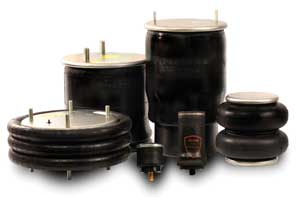
All vehicles with air springs have a specified ride height—established by the OEM—that can be found in the manufacturer’s service manual. This height should be maintained within a 1/4 in., according to Firestone’s Vanette, who says, “The dimension can be checked while the vehicle is loaded or empty. Inspectors should also look at the height control valve to make sure it is functioning properly and there are no leaks.”
On the other hand, SAF-Holland’s Mike Edlund, suspension application engineer, says ride heights are designed to have certain amounts of travel—the general rule of thumb is that they retain 3 in. of travel in either direction. If set too low, a harsh ride can occur due to the constant bumping and thrashing against the air spring bumpers. “If this happens over long periods of time, it can cause structural damage to the trailer frame, damage cargo and reduce the ride quality of the vehicle,” Edlund says.
“Too often, technicians are prone to replacing shock absorbers rather than identifying the root cause of the problem,” he continues. “To avoid reoccurrences, technicians should fully examine the system and identify the correct cause of the problem. A good time to perform visual inspections is when the vehicle is in for a brake job. This allows time to examine the suspension’s components and ensure they are in good condition.”
Dave Ball, senior engineer of air springs for Veyance Technologies, adds that suspension manufacturers design systems to maintain a height that provides optimal ride. Automatic leveling systems—called height control valves—are used to ensure the air spring’s internal pressure is adjusted to keep the height at the same level, whether the trailer is loaded or empty, he says.
The height control valve “automatically adds or exhausts air from the suspension as a trailer is loaded or unloaded, maintaining the designed ride height,” explains Meritor’s Franks. “Proper maintenance is a must to assure the height control valve is functioning correctly.”
The valve is installed so that no air flows into or out of the suspension air springs when the suspension is at the correct ride height, Hendrickson’s Rushe adds. “When the trailer is loaded, the trailer will drop, moving the height control valve arm so that air is supplied to the air springs until the correct ride height is reached. When the trailer is unloaded, the excess air in the air springs raises the trailer, causing the height control valve to exhaust the air from the air springs until the trailer is back at the preset ride height.”
Causes of air suspension wear
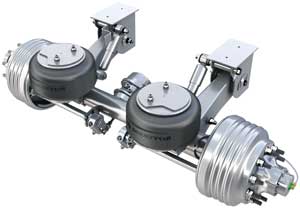
Air suspension component wear causes vary depending on the suspension design. According to Rushe, some designs require periodic fastener maintenance in order to prevent wear or component deterioration; some also require periodic disassembly and inspection of key components.
“Height control valves can wear over time and require replacement. More typically, [they] become contaminated or damaged, requiring cleaning or replacement,” he says. “On suspensions equipped with shock absorbers, the shock seals can begin to wear and leak hydraulic fluid. If too much fluid is lost, the shocks can become ineffective and possibly lead to increased tire wear. However, some hydraulic fluid ‘misting’ can be observed on the outside of the shock. This is a typical condition caused by the hydraulic fluid vaporizing and escaping past the seals. Very little fluid is lost in these cases, resulting in no shock performance reduction.”
Rushe adds that air springs are typically replaced due to damage, not wear. Operating the suspension at the proper ride height will eliminate air spring damage caused by improper suspension setup.
The majority of premature air spring failures are caused by other problems associated with the suspension system, notes Vanette, who adds the wear and tear of road travel can take its toll on the components of the suspension system, causing certain malfunctions:
“Air lines may break loose and rub against air springs, causing abrasions or tears in the rubber bellows. Bushings may wear out and cause similar damage due to misalignment of the air spring. The most common problem found in non-warranty air spring product returns is overextension of the air spring, typically caused by a broken shock absorber. When a shock absorber breaks, it allows the air spring to expand too far and essentially tears the air spring apart.”
According to Franks, lack of regular maintenance is typically the biggest reason for undue wear of suspension components. In addition, “improper installation of an air suspension is a common cause of wear and issues such as tire wear due to improper axle alignment; worn bolted connections (pivot, shock, etc.) due to improper torques; and worn air bags due to being operated outside of a suspension’s designed ride height,” he says.
Maintenance recommendations
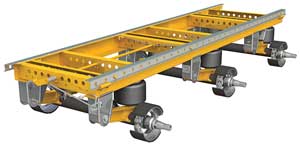
Edlund offers several maintenance tips, including visual inspection of the shock absorbers on at least a weekly basis. “You can see when a shock is leaking,” he explains. “Another way to check the shock is by grabbing the lower shock body after the trailer has been operating; if it is warm, the shock should be functioning properly.”
Preventing the rubber air cell of an air spring from drying out is key, he says, adding, “As long as nothing gets in to rub against it or damage it, the air spring will provide many miles.”
The life an air spring depends on the type of application, Edlund adds. High off-road usage will typically cause wear out before an on-highway application will. “It is good practice to keep the air spring and lower piston clean of debris. This can be accomplished with a mild soap and water solution. In general, air springs last considerably longer than shock absorbers.
“The pivot fastener must provide a sufficient clamp load through the bushing to prevent premature bushing and/or bushing core failure,” Edlund adds. “To ensure this, it is good practice to re-torque the pivot connections every time you do a brake job. We recommend re-torqueing every 50,000 to 100,000 mi. Of course, if brake jobs are performed more frequently due to a severe-duty application, check torque more often.”
He says that after approximately 5,000 miles on a new trailer, the torque ratings on all critical fasteners should be checked to ensure everything was assembled correctly—this may identify problems before any real damage has been done.
“Using the recommended replacement parts is also key to reducing suspension maintenance and extending component life,” says Rushe. “Many aftermarket ‘will fit’ parts are designed to fit into the component location, but they do not have the performance and durability specifications that have been developed by the suspension manufacturer. Following the suspension manufacturer’s recommend maintenance requirements will also help to prolong the life of the suspension components and reduce maintenance costs over the life of the trailer.”
Vanette says that during an air spring inspection, technicians should take special note of any debris, cuts, deformities or rubs that may lead to an imminent failure. If the air spring is damaged, replace it during this visual inspection process, since there is a high probability there may be other problems with the suspension or other damaged components.
“Firestone recommends performing a thorough inspection annually by cleaning the air springs with soapy water or an alcohol solution,” he adds. “This will expose problems hidden from a normal visual inspection. Soap bubbles may also detect any slow leaks that could be occurring, indicating a failing air spring.”
Vanette also cautions not to use an impact wrench when installing new air springs. “An impact wrench increases the danger of stripping the fittings off the bead plate. It is recommended to use torque wrenches to tighten the mounting hardware such as nuts and bolts, and valves. Make certain that all items are tightened properly, and if loose, re-torque to manufacturer’s specifications.”
Replacement guidelines
Unless there was an accident or other significant damage, it normally is unusual to replace a complete existing air suspension, according to SAF-Holland’s Hicks, who says that while some individual components can be relatively easy to change out for repair (air springs, shocks, HCV, etc.), significant structural components require more work.
“Retrofits of one air suspension to another have been done and can be a major undertaking,” he notes. “Typically, these retrofit situations are the result of changing to a newer model to update the trailer, changeover from mechanical to air ride suspension or some other situation that the fleet, end user or OEM determines is needed to address operational issues or field complaints. I cannot emphasize this enough that such retrofits are major events for all but the most skilled workshops and normally require approvals and instructions from the trailer OEM engineering group, as well as possibly the suspension supplier.”
Hicks adds that since most air suspension designs have proprietary and dimensionally unique elements, there is very limited interchangeability with components among competitive designs. Because each suspension is typically designed to match a trailer type/model, mixing and matching components is discouraged, as the wrong component can have a very detrimental impact on the suspension’s overall performance.
“Typically, the easiest and most cost effective replacement plan is to rebuild or repair the unit with the OE supplied suspension system,” he says. “This would not require extensive frame modifications or alterations to the trailer since the frame hangers, supporting cross members, etc. will be in the correct location.
“If the replacement suspension is not the OE specification, more upfront engineering and frame customization will likely be required to properly locate the important structural support attachments—frame hangar, X-members, shock mounts, etc.—because suspension dimensional configuration can vary greatly.”
Hendrickson’s Rushe agrees that replacing an existing air suspension with the same suspension brand is fairly straightforward, adding that a trailer mounting surface and support structure inspection should be performed, and the suspension manufacturer’s installation procedures should be followed.
“When replacing an existing air suspension with a different brand or model, different mounting and support structures may be required,” he says. “The new suspension’s installation instructions should be used to review the trailer structure, and the application and installation requirements should also be reviewed with the suspension manufacturer.
“Changing an existing mechanical leaf spring suspension will typically require a complete replacement of all of the suspension components, including the axle,” Rushe continues. “However, some of the axle brake components and the wheel end components can be reused. For a non-slider installation, new trailer support components will be required. For a slider installation, many air suspension sliders can simply be installed into the existing trailer mounting, but a slider review would be needed to ensure the correct set of slider options is selected.”
Vanette, who notes that Firestone Airide Air springs are engineered to meet OEM specifications, says that deviating from the OEM engineering spec can cause premature failure. “For example, an air spring that is taller than the OEM suspension spec could possibly come in contact with bolts or other pieces of the suspension, causing interference with air spring functionality or leading to a rupture,” he says. “An air spring that is wider in diameter than the OEM specification could also cause the air spring to rub or puncture. Lastly, if an air spring is too short, it can pull the air spring end attachments, ultimately leading to an air leak or damage of other suspension components.
“The life of an air spring is dependent on the application and maintenance of the air spring as well as the quality of the spring,” Vanette concludes.
Taking all this into account, the benefits and cost savings offered by trailer air suspensions are significant, provided proper maintenance procedures are followed. Skilled maintenance technicians should have no trouble switching out individual components, but if a complete replacement is required, fleets should work closely with the suspension manufacturer to ensure the proper guidelines are followed.





